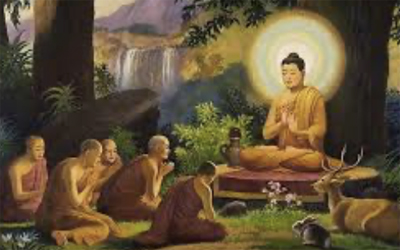Anattalakkhaṇa Sutta (Saṃyutta Nikāya)
Thus have I heard. On one occasion the Blessed One was dwelling at Benares in the Deer Park at Isipatana. There the Blessed One addressed the bhikkhus of the group of five thus: “Bhikkhus!”
“Venerable sir!” those bhikkhus replied. The Blessed One said this:
“Bhikkhus, form is non-self. For if, bhikkhus, form were self, this form would not lead to affliction, and it would be possible to decree to form: ‘Let my form be thus; let my form not be thus.’ But because form is non-self, form leads to affliction, and it is not possible to decree to form: ‘Let my form be thus; let my form not be thus.’
“Feeling is non-self. For if, bhikkhus, feeling were self, this feeling would not lead to affliction, and it would be possible to decree to feeling: ‘Let my feeling be thus; let my feeling not be thus.’ But because feeling is non-self, feeling leads to affliction, and it is not possible to decree to feeling: ‘Let my feeling be thus; let my feeling not be thus.’
“Perception is non-self. For if, bhikkhus, perception were self, this perception would not lead to affliction, and it would be possible to decree to perception: ‘Let my perception be thus; let my perception not be thus.’ But because perception is non-self, perception leads to affliction, and it is not possible to decree to perception: ‘Let my perception be thus; let my perception not be thus.’
“Volitional constructions are non-self. For if, bhikkhus,volitional constructions were self, these volitional constructions would not lead to affliction, and it would be possible to decree to volitional constructions: ‘Let my volitional constructions be thus; let my volitional constructions not be thus.’ But because volitional constructions are non-self, volitional constructions lead to affliction, and it is not possible to decree to volitional constructions: ‘Let my volitional constructions be thus; let my volitional constructions not be thus.’
“Consciousness is non-self. For if, bhikkhus, consciousness were self, this consciousness would not lead to affliction, and it would be possible to decree to consciousness: ‘Let my consciousness be thus; let my consciousness not be thus.’ But because consciousness is non-self, consciousness leads to affliction, and it is not possible to decree to consciousness: ‘Let my consciousness be thus; let my consciousness not be thus.
“What do you think, bhikkhus, is form permanent or impermanent? “Impermanent, venerable sir.” “Is what is impermanent suffering or happiness?” “Suffering, venerable sir.” “Is what is impermanent, suffering, and subject to change fit to be regarded thus: ‘This is mine, this I am, this is my self’?” “No, venerable sir.”
“Is feeling permanent or impermanent? “Impermanent, venerable sir.” “Is what is impermanent suffering or happiness?” “Suffering, venerable sir.” “Is what is impermanent, suffering, and subject to change fit to be regarded thus: ‘This is mine, this I am, this is my self’?” “No, venerable sir.”
Is perception permanent or impermanent? “Impermanent, venerable sir.” “Is what is impermanent suffering or happiness?” “Suffering, venerable sir.” “Is what is impermanent, suffering, and subject to change fit to be regarded thus: ‘This is mine, this I am, this is my self’?” “No, venerable sir.”
Are volitional constructions permanent or impermanent? “Impermanent, venerable sir.” “Is what is impermanent suffering or happiness?” “Suffering, venerable sir.” “Is what is impermanent, suffering, and subject to change fit to be regarded thus: ‘This is mine, this I am, this is my self’?” “No, venerable sir.”
“Is consciousness permanent or impermanent?” “Impermanent, venerable sir.” “Is what is impermanent suffering or happiness?” “Suffering, venerable sir.” “Is what is impermanent, suffering, and subject to change fit to be regarded thus: ‘This is mine, this I am, this is my self’?” “No, venerable sir.”
“Therefore, bhikkhus, any kind of form whatsoever, whether past, future, or present, internal or external, gross or subtle, inferior or superior, far or near, all form should be seen as it really is with correct wisdom thus: ‘This is not mine, this I am not, this is not my self.’
“Any kind of feeling whatsoever, whether past, future, or present, internal or external, gross or subtle, inferior or superior, far or near, all feeling should be seen as it really is with correct wisdom thus: ‘This is not mine, this I am not, this is not my self.’
“Any kind of perception whatsoever, whether past, future, or present, internal or external, gross or subtle, inferior or superior, far or near, all perception should be seen as it really is with correct wisdom thus: ‘This is not mine, this I am not, this is not my self.’
“Any kind of volitional constructions whatsoever, whether past, future, or present, internal or external, gross or subtle, inferior or superior, far or near, all volitional constructions should be seen as it really is with correct wisdom thus: ‘This is not mine, this I am not, this is not my self.’
“Any kind of consciousness whatsoever, whether past, future, or present, internal or external, gross or subtle, inferior or superior, far or near, all consciousness should be seen as it really is with correct wisdom thus: ‘This is not mine, this I am not, this is not my self.’
“Seeing thus, bhikkhus, the instructed noble disciple becomes disenchanted with form, disenchanted with feeling, disenchanted with perception, disenchanted with volitional constructions, disenchanted with consciousness. Being disenchanted, he becomes dispassionate. Through dispassion (his mind) is liberated. When it is liberated there comes the knowledge: ‘It is liberated.’ He understands: ‘Destroyed is birth, the holy life has been lived, what had to be done has been done, there is no more for this world.’ “
That is what the Blessed One said. Being pleased, those bhikkhus delighted in the Blessed One’s statement. And while this discourse was being spoken, the minds of the bhikkhus of the group of five were liberated from the taints by non-clinging.
Source: Saṃyutta Nikāya, The Connected Discourses of the Buddha, Bhikkhu Bodhi.


